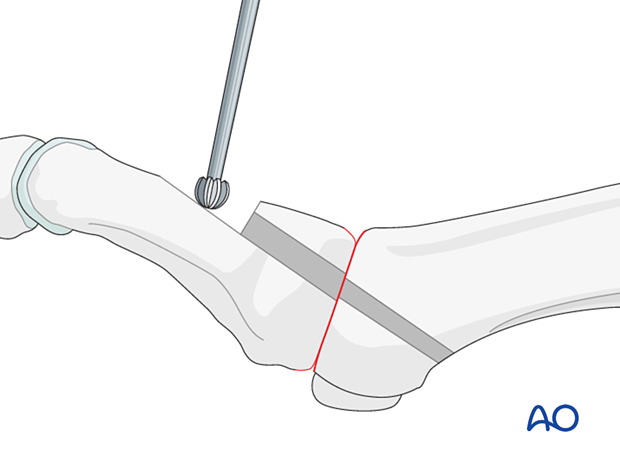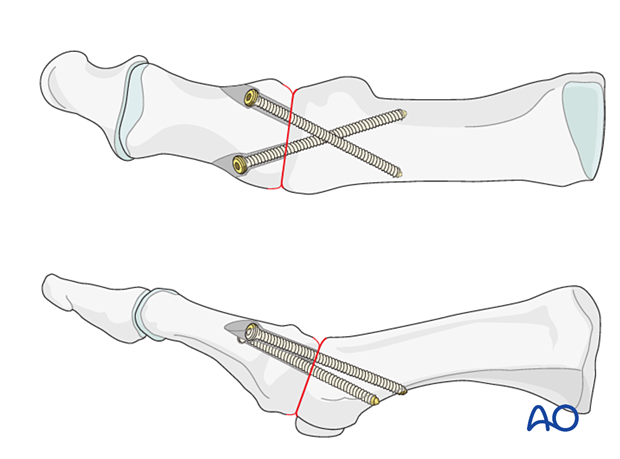Arthrodesis of 1st MTP joint
1. General considerations
If fragmentation is such that the joint cannot be reconstructed, the options are:
- Nonoperative treatment
- excision arthroplasty
- prosthetic replacement
- primary fusion
None of these options are ideal.
The results may be unsatisfactory because of the fracture’s intraarticular nature, and the patient may complain of pain and stiffness.
Replacement prosthesis exists but will not be covered here.
As fusion is permanent, the decision to perform fusion should be considered for only significantly damaged articular surfaces.
The fusion can be fixed using either lag screws or a plate.Metatarsals fractures are different than long bone fractures.
- The bones are small
- Fracture gaps are small
Thus, following the AO principles is less critical than long bones, and often isolated screws or K-wires alone will work satisfactorily.
Restoration of length, rotation, and angulation is critical due to the importance for proper foot biomechanics.
Soft tissue injury
These fractures can have a severe associated soft tissue injury. Repeat debridement may be required.
Anatomical considerations
Proper alignment of the metatarsal heads is a critical goal in restoring the forefoot mechanics.
A normal curved “cascade” (Lelièvre’s parabola) appearance, which is symmetric with the other foot, is mandatory on the AP view. See illustration. This symmetry ensures that the normal length of the metatarsal is restored.
It is also critical to restore the metatarsals in their axial or horizontal plane so that all the metatarsal heads are on the same level in the axial view.
Any malalignment, particularly flexion, will recreate focally high pressure during the stance phase and toe-off, resulting in pain and subsequent callus formation.
The sesamoids, rather than the first metatarsal head, bear weight in the first row. Therefore, one must look at the sesamoid level in establishing the alignment in the axial or horizontal plane of the first metatarsal.

Fixation
Compression of the arthrodesis is obtained using lag screws.

Plates are used to neutralize the lag screws.
A dorsal plate is less prominent than a medially placed plate.
Custom-made fusion plates are very robust but may not be available.
Generic 2.7 plates can be used but risk fracturing; thus, the application of two plates may be advised.

Timing of surgery
The timing of surgery is influenced by the soft tissue injury and the patient's physiologic status.

2. Patient preparation
This procedure is typically performed with the patient placed supine with the knee flexed at 90°.

3. Approach
Selection of approach
Fusion may be performed through either the:
The dorsal approach is utilized when a first metatarsal MTP joint fusion plate is used.

Visualization
Expose the articular surfaces.
Visualization will be improved by longitudinal manual distraction and by releasing the dorsal insertion of the extensor hallucis brevis (EHB).

4. Irrigation and debridement
Irrigate the fracture site using a syringe.
Displaced fracture fragments are debrided and mobilized with a dental pick or Freer elevator.
Once adequate visualization has been achieved and the joint thoroughly irrigated, examine the extent of articular surface involvement to validate the preoperative plan of primary fusion versus ORIF.
If joint comminution is not extensive, it may be possible to perform fixation.

5. Preparation of joint for fusion
Preparation of joint for fusion
Remove the cartilage from the adjacent bone using a curette.

Penetrate the subchondral bone using a high-speed burr to promote bone growth.

The bone may need further debridement to ensure a large contact surface.
An oscillating saw may be used instead of a burr.
An excessive bone resection will result in shortening.

The positioning of the hallux
Position the hallux in 15° of dorsiflexion relative to the floor's plane and 5°–10° of valgus relative to the first metatarsal.
Temporarily fix the position using a K-wire inserted from dorsal to plantar.
If a precontoured plate is going to be used, one can confirm proper joint position by applying the plate to the dorsal surface of bone before lag screw fixation.
Before permanent fixation, ensure that the two bone ends are intimate and use intraoperative radiographs to confirm correct rotation and alignment. The arthrodesis will lead to a small, acceptable shortening of the first ray.

6. Fixation
Lag screw fixation
Ideally, two lag screws (3.5 mm) are inserted in a diverging pattern from dorsomedial to plantar lateral.
Countersink the gliding holes to reduce screw prominence.
The screws should fully engage the bone proximally but should not be prominent at the metatarsal head’s plantar surface, which may cause pain.


The screws may also be inserted in a crossing pattern.

The screws should not cross at the MTP interface.

Neutralization fusion plate
Plate contouring is essential to fit the surface of the bone.

The plate is applied in neutralization mode and fixed using a minimum of two screws in each bone segment.
If generic mini fragment plates are used, two plates are recommended to maximize the rigidity of the fusion construct.

7. Aftercare
An appropriate well-padded dressing should be applied to protect the surgical incision. Compression will help control swelling.
If present, the skin-pin interface should be similarly well-padded but with dressings that can be readily removed to inspect for pin site infection.
Immediate postoperative treatment is rest, ice, and elevation.
The patient should restrict weight-bearing for six weeks until signs of radiographic healing are present. After this, patients can be weight-bearing as tolerated.
Patients must exercise their ankle and subtalar joints out of the orthosis to prevent stiffness (eg, by stretching their Achilles).
X-ray the metatarsals at six weeks to confirm satisfactory union and remove K-wires if present. Once the fracture is united, the orthosis may be gradually discontinued.
A gastrocnemius release may need to be performed in cases with postoperative gastrocnemius contracture. This occurs more typically in the mid- and hindfoot.
If the gastrocnemius muscle has been released, a splint or cam walker can be used to protect the surgical site.













